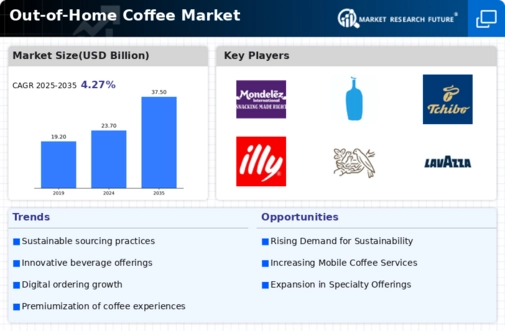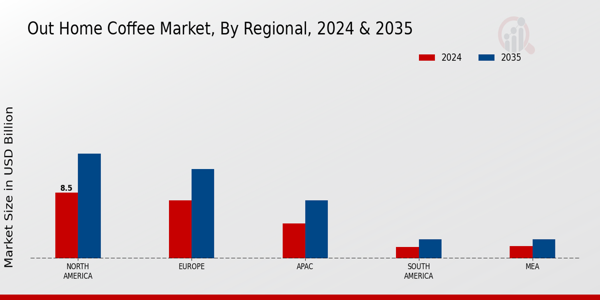The Out-of-Home Coffee Market is growing substantially, and among the major driving forces is the increasing interest of consumers in quality and convenience. There is a growing coffee culture, especially among millennials and even younger generations, which increases coffee consumption beyond the home. This trend is also buoyed by the popularity of artisanal, specialty coffee drinks since the customers' expectations when buying coffee are of something distinctive, one of a kind. In addition, advances in coffee making and serving, like mobile orders and delivery services, have also contributed to improved customer experience.
There are many possibilities that businesses can seize in the international out-of-home coffee market. Brands have an opportunity to create sustainable products and packaging owing to the increased focus on sustainability in this global market. There is also an increasing demand for local products, and businesses can cater to this need by collaborating with local roasters and retailing unique blends. Moreover, the use of technology in coffee experiences can enhance customer interaction and satisfaction, for instance, through mobile apps that allow users to participate in loyalty programs or receive personalized suggestions.
These opportunities will allow businesses to stand out from their competitors and make the most out of the industry. Recent tendencies show that, in contrast, organic, low-calorie coffee is being promoted as it is healthy.
There is also a rise in plant-based alternatives, such as oat and almond milk, which cater to those with dietary preferences. Additionally, social media plays a significant role in promoting coffee brands and trends, creating a community of coffee enthusiasts. The market is witnessing an increase in creative beverages, blending coffee with unique flavors and ingredients. These emerging trends point to a dynamic future for the out-of-home coffee sector, with businesses needing to adapt to changing consumer demands.
Increasing Coffee Consumption Trends
The rising trend of coffee consumption around the world is one of the primary drivers of the Out-of-Home Coffee Market Industry. As lifestyles become more hectic, many consumers find value in the convenience offered by out-of-home coffee options. The culture of 'grabbing a coffee on the go' has been rapidly growing, influenced by busy work schedules and the rising emphasis on social interactions that often revolve around coffee consumption.
Coffee shops, cafes, and other establishments that cater to out-of-home coffee consumers have gained popularity as they provide not only high-quality beverages but also a social space where people can connect.Moreover, specialty coffee, beverages tailored to individual preferences, and the introduction of new flavors and blends have contributed significantly to consumer interest and demand. This shift is not just limited to developed countries but is also becoming pronounced in emerging markets where coffee culture is on the rise.
The ease of availability and the increasing number of coffee establishments, combined with innovative marketing strategies, have further stimulated the market.With the expectation of steady growth in the overall market valuation, these factors are likely to reinforce the increasing trend of coffee consumption, making it a pivotal driver in predicting future success in the Out Home Coffee Market. The integration of technology, such as mobile ordering and loyalty apps, has further enhanced customer experience, thus drawing in more consumers. Thus, the increasing coffee consumption trends serve as a major catalyst for growth in this sector.
Expansion of Coffee Shop Chains
The rapid expansion of coffee shop chains across various regions is significantly propelling the Out-of-Home Coffee Market Industry forward. As major brands continue to establish new locations and strengthen their presence internationally, consumers are increasingly drawn to these outlets for their reliable product offerings. Chains often provide innovative beverages and promotions that create a sense of community around coffee consumption. This expansion not only adds to the convenience for consumers but also makes a broad range of coffee products more accessible, thereby fueling market growth.
Health Consciousness Among Consumers
Growing health consciousness among consumers is driving changes in their coffee consumption habits, promoting the development of the Out-of-Home Coffee Market Industry. As people become more aware of their dietary choices, many seek healthier coffee options that align with their lifestyle. This includes organic coffee, low-calorie beverages, and specialty drinks that tout health benefits. The shift towards these healthier alternatives not only enhances consumer satisfaction but also positions out-of-home coffee providers to innovate and meet these evolving preferences.
The Global Out-of-Home Coffee Market is poised for robust growth, driven by evolving consumer preferences towards premium coffee experiences and the increasing prevalence of coffee shops in urban environments.
U.S. Department of Agriculture
















